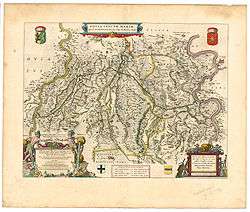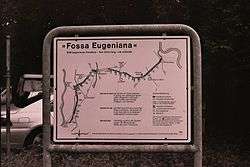Fossa Eugeniana
The Fossa Eugeniana or Spanish Rhine-Maas canal [1] was a large-scale ambitious project of the Spanish-Dutch Eighty Years' War planned by the then Spanish regent in Brussels, Isabella Clara Eugenia, after whom it was named, during the years 1626–1630. It consisted of a fortified canal intended to blockade the United Provinces and to divert trade from the Rhine near Rheinberg just south of Wesel and reroute it to Venlo on the Maas, in Spanish territory.[2] The Spanish Rhine-Maas canal had military importance, when at the time Spanish garrisons in north-western Germany reached their maximum extent, amounting to around fifty fortresses and forts.[3] It was to be 25 metres (82 ft) wide, 1.4 metres (4.6 ft) deep and 60 kilometres (37 mi) long. The Fossa Eugeniana was never finished. A 5.7 km section west of Geldern is in use as drainage canal. It is known under the name Grift.


Notes
- Israel, p. 38.
- Wilson, p. 371.
- Israel, p. 38.
References
- Wilson, Peter Hamish. The Thirty Years War: Europe's Tragedy. Penguin, 2009. ISBN 978-0-674-03634-5.
- Israel, Jonathan Irvine. Conflicts of Empires: Spain, the Low Countries and the Struggle for World Supremacy, 1585-1713. London, 1997. ISBN 1-85285-161-9.
- Zijlmans, Roel. Troebele betrekkingen: Grens-, scheepvaart- en waterstaatskwesties in de Nederlanden tot 1800, chapter 5. Hilversum, 2017. ISBN 978-90-8704-637-8.